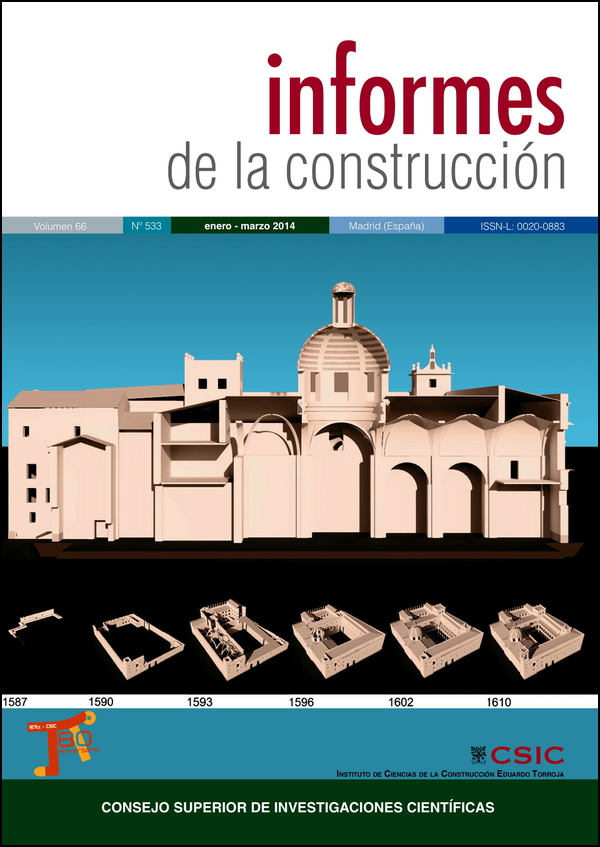Vertical safety nets closing façade gaps
DOI:
https://doi.org/10.3989/ic.11.132Keywords:
Net, safety, façade, fall, impactAbstract
Among other methods, vertical safety nets on the façades of buildings during the construction stage are used in Spain as an alternative to other safety systems in order to avoid falls to a different level. There are two kinds of such nets: floor-to-ceiling nets - that secure the entire void between successive floors in structure construction stage-, and small nets what secure windows and other minor voids in later stages. Their design and requirements are not defined at present, but the AEN/CTN81/SC2/GT7 Spanish Working Group is drafting a specific regulation named Pr UNE 81651. Some members of the Civil Engineering Department of the University of Alicante, having experience in other systems of protection, have developed several finite-elements numerical models to measure and analyse mechanical variables related to a possible fall of a person over this kind of net, characterised by a kinetic energy lower than for other types. In this paper the obtained results are shown, for both large and little nets, analysing the anchorages gap, void openings at perimeter, maximum net deflection and net disposal (square/diamond) repercussion, as well as its consequences on the victim’s safety (impact factor).
Downloads
References
(1) Consejo Europeo. (1989). Directiva 89/391/CEE del Consejo, de 12 de junio de 1989, relativa a la aplicación de medidas para promover la mejora de la seguridad y de la salud de los trabajadores en el trabajo. Diario Oficial, n° L 183 de 29/06/1989 pp.0001-0008.
(2) Cortes Generales. (1995). Ley 31/1995 de Prevención de Riesgos Laborales. Boletín Oficial del Estado, nº 269, (España).
(3) Ministerio de la Presidencia. (1997). R. D. 1627/1997 de 24 de octubre de 1997 por el que se establecen disposiciones mínimas de seguridad y de salud en las obras de construcción. Boletín Oficial del Estado, nº 256, (España).
(4) AENOR-CEN. (2004). UNE-EN 1263 Redes de Seguridad. Parte 1: Requisitos de seguridad, métodos de ensayo. Asociación Española de Normalización (AENOR).
(5) AENOR-CEN. (2004). UNE-EN 1263 Redes de Seguridad. Parte 2: Requisitos de seguridad para la instalación de redes de seguridad. Asociación Española de Normalización (AENOR).
(6) AENOR-CEN. (2013). UNE-EN 13374 Sistemas provisionales de protección de borde. Especificaciones del producto, método de ensayo. Asociación Española de Normalización (AENOR).
(7) Saiz, J., Irles, R., Arcenegui, G.A., Naharro, M. (1997). Las Redes de Seguridad en la Construcción. Univ. de Alicante - D.G.T. (Generalitat Valenciana). Alicante (España).
(8) Segovia, E. (2005). Criterios para el diseño de los sistemas anticaída utilizados en construcción y sometidos a impacto. (Tesis Doctoral) Univ. Politécnica de Valencia. Dtº Mecánica de Medios Continuos y Teoría de Estructuras.
(9) Riquelme-Moya, P., Romero-Flores, S., Irles-Mas, R., Segovia-Eulogio, E. (2011). Redes de seguridad verticales en fachada. Workshop - Investigación e innovación en protecciones colectivas y medios auxiliares de edificación, Madrid.
(10) Riquelme-Moya, P. (2010). Análisis de un modelo numérico para redes pequeñas de seguridad en construcción: parámetros de diseño (Trabajo de investigación para diploma de estudios avanzados). Universidad de Alicante.
(11) Romero-Flores, S. (2010). Análisis del comportamiento frente al impacto en redes de seguridad de cierre vertical de paño grande (Trabajo de investigación para diploma de estudios avanzados). Universidad de Alicante.
(12) Pomares-Torres, J.C., Irles-Mas, R., Segovia-Eulogio, E. (2011). Personal protection rails for strong impacts. 4th International Conference on Safety and Security Engineering, Amberes (Bélgica).
(13) Romero-Flores, S., Riquelme-Moya, P., Irles-Mas, R., Segovia-Eulogio, E. (2011). Floor to ceiling vertical safety nets. 4th International Conference on Safety and Security Engineering, Amberes (Bélgica).
(14) Irles, R., González, A., Segovia, E., Maciá, A. (2002). Las redes verticales de seguridad en la construcción de edificios I. Informes de la Construcción, 53(477): 21-29.
(15) Irles, R., González, A., Segovia, E., Maciá, A., Pomares, J. C. (2007). Las redes verticales de seguridad en la construcción de edificios II. Informes de la Construcción, 59(505): 37-51.
(16) Irles, R., Maciá, A, Segovia, E., Saiz, J. (1998). Redes verticales de seguridad. Resultados teóricos y experimentales. III European Forum in Science, Security and Health, Oviedo (España).
(17) Arcenegui, G., Saiz, J., Irles, R., Naharro, M. (1998). Les Filets de Sécurité sur supports de type potence. Int. Fall Protection Symposium, Wuppertal (Alemania).
(18) Sulowski, A. C. (2006, 14-15 de junio). How good is the 8kN Maximum Arrest Force limit in industrial Fall Arrest Systems? Int. Fall Protection Symposium, Seattle, WA.
(19) Paureau, E., Parisot, E., Schuler, B. (1989). Filets en grandes nappes. Eficacité, performances, règles de pose. Cahiers de notes documentaires 137(4e): 655-675.
Published
How to Cite
Issue
Section
License
Copyright (c) 2014 Consejo Superior de Investigaciones Científicas (CSIC)

This work is licensed under a Creative Commons Attribution 4.0 International License.
© CSIC. Manuscripts published in both the print and online versions of this journal are the property of the Consejo Superior de Investigaciones Científicas, and quoting this source is a requirement for any partial or full reproduction.
All contents of this electronic edition, except where otherwise noted, are distributed under a Creative Commons Attribution 4.0 International (CC BY 4.0) licence. You may read the basic information and the legal text of the licence. The indication of the CC BY 4.0 licence must be expressly stated in this way when necessary.
Self-archiving in repositories, personal webpages or similar, of any version other than the final version of the work produced by the publisher, is not allowed.















